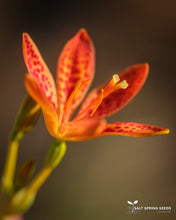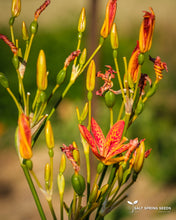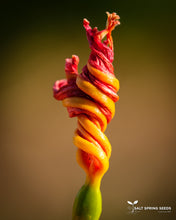30 seeds/pkt
A beautiful addition to any garden, Leopard Lily (She-gan) has a long history of use in traditional Chinese medicine. Native to Eastern Russia, China, and Japan it is not a true Lily, but a member of the Iris family (Iridaceae). The golden rhizome, harvested after at least 3 seasons in late autumn or early spring, contains several medically active constituents including flavonoids, isoflavonoids, and glucosides.
Acting mainly on the upper respiratory tract, lungs and liver, the dried rhizome of this bitter cooling herb lowers fevers and reduces inflammation and is effective against several bacterial, fungal, and viral organisms. Currently, studies are underway to investigate its apparent potential to treat prostate cancer.
This hardy (zones 5-10) herbaceous perennial monocot prefers moist loamy soil and full sun to part shade. From clumps of flat, sword-like leaves arranged in a fan growing up to 2 feet, upright stalks emerge from midsummer, bearing multiple short lived (just a day) exotic flowers. These beautiful flowers are 2-3” wide with 6 equally sized waxy yellow/orange petals with maroon/crimson speckles. The fertilized ovaries give rise to pear shaped green seedpods, maturing to a fawn colour, and splitting open to reveal the seed cluster that resemble a Blackberry. It’s helpful to stake the tall flower stalks as they often flop or are blown over in strong winds.
Seeds can be sown autumn fresh in a cold frame, in the early spring directly in cool garden soils, or stratify 7 to 30 days in cold, moist conditions and then sow in pots or flats in the greenhouse. Be patient as germination can take anywhere between 2 to 8 weeks! Prick out and pot-up the individual seedlings when they are large enough to handle. They can be planted out 1 to 2 feet apart in early autumn, flowering in the following season. If started in the autumn and planted out early enough the following spring, plants will flower that season. Propagation may also be by root division in spring or early autumn.
Be aware that slugs really love this plant and can destroy even quite large emerging clumps in the spring.
(Note - Do Not prescribe for pregnant women especially during the first trimester of pregnancy as can induce the fetus to abort.)






